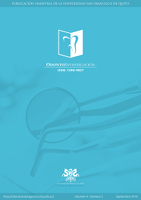Management of a pseudoaneurysm of the sphenopalatine artery following a Le Fort I osteotomy
Main Article Content
Abstract
Article Details
References
Cunningham, L.; Van Sickels, J. y Brandt, M. Angioghapic Evaluation of the Head and Neck. Atlas of the Oral and Maxillofacial Surgery Clinics North America. 2003; 11(1) 73-86.
Carmo Galindo, C; Augusto Lima C; Galindo Filho, G y Marcondes Penha F. True atherosclerotic aneurysm of the facial artery. International Journal of Oral and Maxillofacial Surgery. 2006; 35 (6) 566-568.
Corvino A.; Catalano O.; Corvino F.; Sandomenico F.; Setola, S.; and Petrillo. A. Superficial temporal artery pseudoaneurysm: what is the role of ultrasound?. Journal Ultrasonographic. 2016; 19 (3) 197-201.
Pappa, H; Richardson D and Niven S. False Aneurysm of the Facial Artery as Complication of Sagittal Split Osteotomy. Journal of Cranio-Maxillofacial Surgery. 2008; 36 (3) 180-182.
Pourdanesh, F; Salehian M; Dehghan, P; Dehghani, N and Dehghani, S. Pseudoaneurysm of the Superficial Temporal Artery Following Penetrating Trauma. The Journal of Craniofacial Surgery. 2013; 24 (4) 334-337.
Silva A; O"™Ryan F; Beckley M; Young H and Poor D. Pseudoaneurysm of a branch of the maxillary artery following mandibular sagittal split ramus osteotomy: case report and literature review, Journal of Oral and Maxillofacial Surgery. 2007; 65(9) 1807-1816.
Morken M; Cappelen Johan; Kvistad K; Sovik E and Stenseath K. Acute Endovascular Repair of Iatrogenic Rigth Internal Carotid Arterial Laceration. Acta Radiologica Short Reports. 2013; 2 (5) 1-3.
Chirichella T; Little J and Gruber B. Lingual Artery Pseudoaneurysm with Arteriovenous Fistula Formation Following a Gun Shot Wound. Journal Surgery Radiology. 2011;1(2)166-169.
Elton V; Turnbull I and Foster M. An Overview of the Management of Pseudoaneurism of the Maxillary Artery: A Report of a Case Following Mandibular Subcondylar Osteotomy. Journal of Craniomaxillofacial Surgery. 2007; 35(1) 52-56.
Masella P; Megan H; Hall B; Verghese J. and Kellicut D. Posttraumatic Lingual Artery Pseudoaneurysm Treated with Ultrasound- Guided Percutaneous Thrombin Injection. Annals Vascular Surgery. 2014; 28 (5) 1317-1322.
Osborne, P.; Sverzut T; Trivellato, A; Matias, C; Sverzut C and Sverzut, A. Carotid Jugular Fistula after Le Fort I Osteotomy. International Journal of Oral & Maxillofacial Surgery. 2017; 46(7) 845-850.
Fonseca, Raymond J. Oral and Maxillofcial Surgery. Volumen III. Volumen Editor: Timothy A. Turvey. Second Edition. El Sevier Saunders. 2009 pp 185-187
Múnera, F.; Soto J.; Palacio, D; Velez S and Medina, E. Diagnosis of Arterial Injuries Caused by Penetrating Trauma to the Neck: Comparison of Helical CT Angiography and Conventional Angiography. Radiology 2000; 216 (2) 356-362.
Lucas O; Naseem H-u-R, Davies J; Reynold R. and Bass K. Endovascular treatment of a carotid artery pseudoaneurysm due to penetrating trauma in a pediatric patient, Journal of Pediatric Surgery Case Reports. 2017; 19 19-21.
Serio, S. and Beeman, B. Delayed Presentation of a Common Carotid Pseudo-aneurysm Following Penetrating Trauma with Retrograde open Carotid Stent graft (ROCS). Annals of Vascular Surgery. 2014; 28 (7) 1799-1804.
Goksu, E; Senay, E and Aksoy C. Superficial temporal artery pseudoaneurysm: ultrasonographic diagnosis in the ED. American Journal of Emergency Medicine. 2009; 27 (5) 627-630.
Noy, D; Rachmiel, A; Emodi, O; Amsalem, Y; Israel, Y. and Nagler, R. Transarterial Embolization in Maxillofacial Intractable Potentially Life-Threatening Hemorrhage. Journal Oral Maxillofacial Surgery. 2017; 75(6) 1223-1231.
Shu-jun, C; Ning, J.; Yu-xuan, C, Xiao-xian, H.; Xue-mei, L.; Yan-kun, L and Xiao-zong,W. A Clinical Study of Large Cervical Vascular Injury in Penetrating Neck Trauma: Report of 6 Cases. China Journal of Oral and Maxillofacial Surgery. 2011: 9(2) 138-142.

